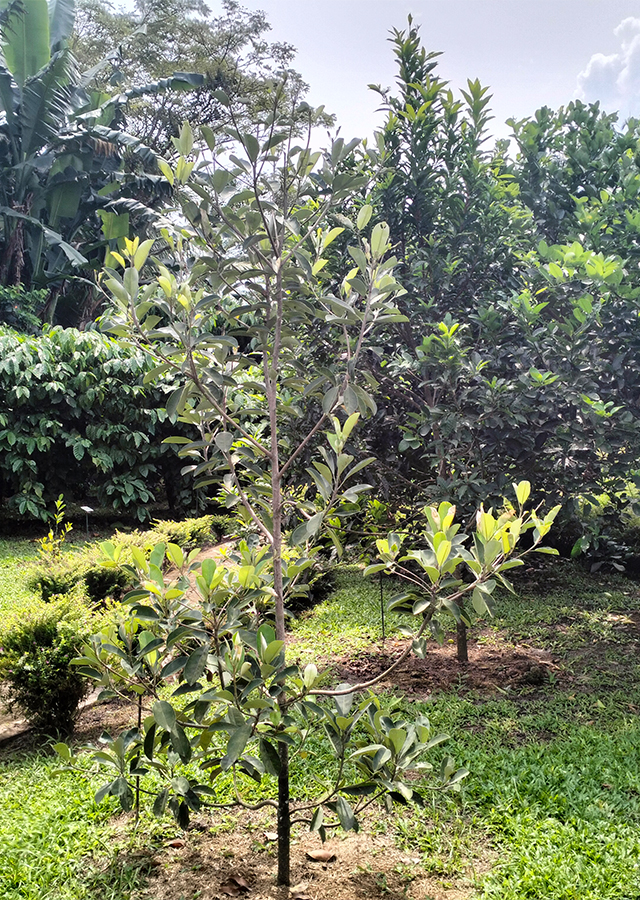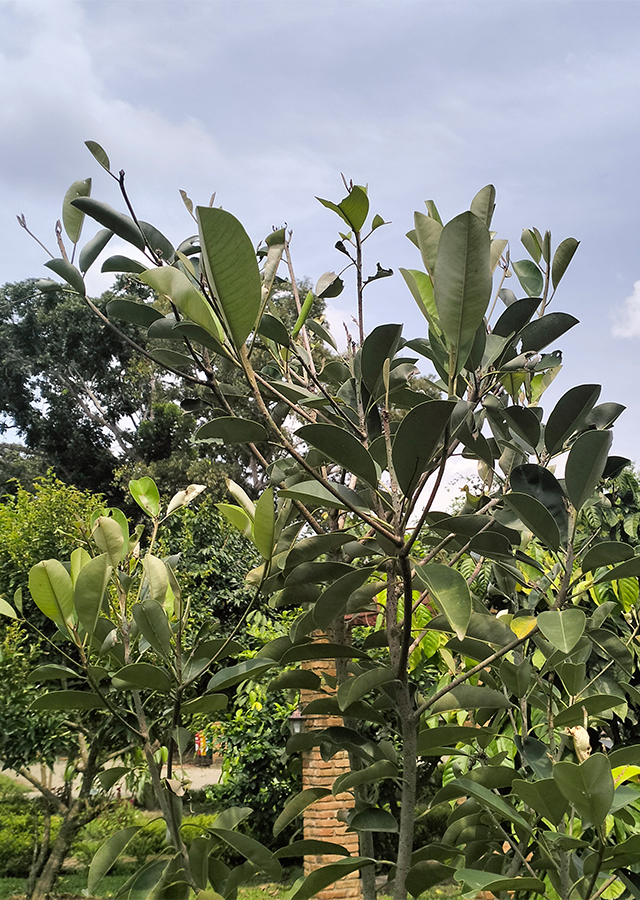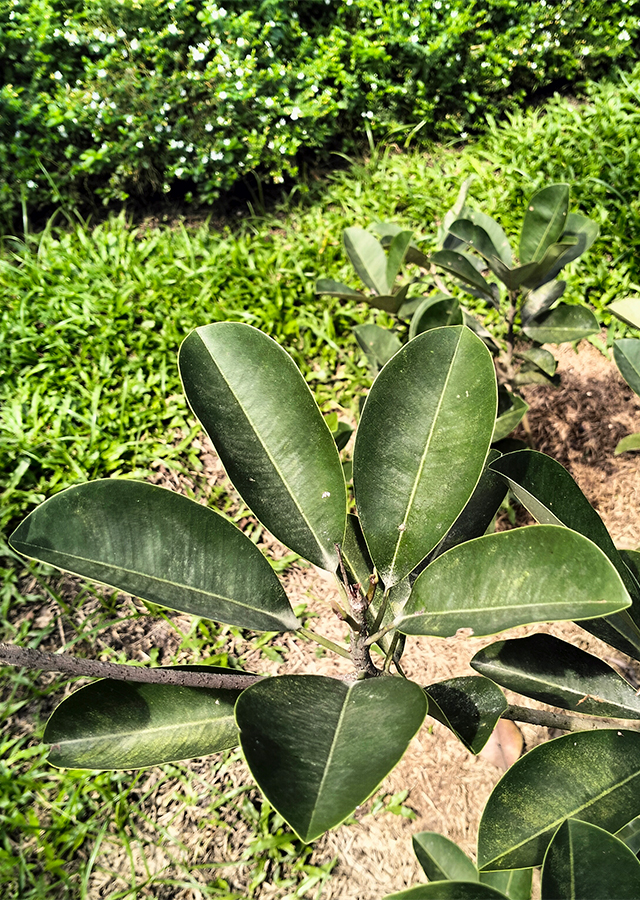Black Sapote
Diospyros nigra (J.F.Gmel.) Perr.
Ebenaceae
Location in our garden
Orchard



Synonym
Diospyros sapota Roxb.
Diospyros digyna Jacq.
Diospyros edulis Lodd. ex Sweet
Habitus
Trees. Evergreen that can grow up to 25 m in height with trunk diameter of up to 45 cm
Part Used
Leaves
Bark
Fruit
Growing Requirements
Full Sunshine
Habitat
Forest
Terrestrial
Overview
Black sapote or Diospyros digyna is a tropical fruit tree native to Mexico, the Caribbean, Central America, and Colombia. It is also known as chocolate pudding fruit, chocolate persimmon, and zapote prieto. Its fruit is consumed raw when fully ripe and/or cooked. Its flesh is dark chocolate brown to black in colour but somewhat sweet and rich in flavour. Immature fruits can also be eaten as vegetable when boiled. Bark and leaves are used medicinally in the treatment of fever and various skin conditions. Though not commonly used, the wood of black sapote is suitable for cabinet work. The main use of this fruit is for direct consumption or as an ingredient for making desserts. In spite of its nutritional characteristics, its rate of consumption is very low, providing an opportunity to make novel ready-to-eat or processed products.
Vernacular Names
Ebénier des Antilles (French), Ebenholzbaum (German), Diosupirosu nigura (Japanese), Guayabota (Mexican), Zapoté negro (Philippines), Ebeno agrio (Spanish), Hei Shi (Taiwan).
Agroecology
A plant of the moist tropics and subtropics. It can be grown at elevations up to 2,000 m, but does best below 600 m. It grows best in areas where annual daytime temperatures are within the range 20 - 27 °C, but can tolerate 12 - 34 °C. It prefers a mean annual rainfall in the range 1,200 - 1,600 mm, but tolerates 1,000 - 2,400 mm. Prefers a sunny position, tolerating some shade. The tree adapts to different soil types and survives flooding, but it is rather sensitive to drought, requiring abundant irrigation in dry areas. Prefers a pH in the range 6 - 7, tolerating 5.5 - 7.5.
Morphology
- Trunks - diameter of up to 45 cm. It has a rounded crown and black bark.
- Leaves - the leathery leaves are about 10-30 cm long and elliptic-oblong to lanceolate-shaped. They are arranged alternately.
- Flowers - the white flowers are borne in the leaf axils and about 1-1.6 cm in diameter.
- Fruits - climacteric berry, oblate to globose; 5-15 cm in diameter, dark olive-green to bright green peel, persistent green calyx.
- Seeds - dark red-brown colored.
Cultivation
Propagated usually by seeds - these will germinate in about 30 days and if properly dried remain viable for several months. Seedlings grow slowly at first, they do not come true to type and may take 4-5 years to begin fruiting. Trees with only male flowers will not produce fruit; trees with female or male and female flowers will bear fruit.
Chemical Constituents
Phenolic compounds, carotenoids, flavan-3-ols, proanthocyanidins, ferulic, citric and sinapic acids.
Traditional Medicinal Uses
- It helps in building the body’s immune system and enhance resistance against bacteria and viruses.
- The fruit is good for the digestive process as it is an excellent source of dietary fiber.
- A 100 gram serving of black sapote provides 410 IU of vitamin A, which plays a major role in maintaining good eyesight.
- Black sapote can be considered as a good source of potassium as it contains about 350 mg of the crucial mineral. It plays a vital role in muscle development, maintains fluid-electrolyte balance and controls the heart’s electrical activity.
- For those who are on a weight loss regimen, black sapote smoothie would be beneficial as it contains fewer calories and also keep satiated.
- Antioxidant activity of black sapote scavenges free radicals and protects against cancer, heart disease, stroke, and other ailments. The fruit enhances the absorption of non-heme iron and promotes would healing. It also helps maintain collagen and connective tissues in the body.
Part Used
Reference Sources
- Plant For A Future. Diospyros digyna - Jacq. https://pfaf.org/user/Plant.aspx?LatinName=Diospyros+digyna. 27-12-22.
- National Parks. Flora & Fauna Web. Diospyros nigra (J.F.Gmel.) Perr. 2020. https://www.nparks.gov.sg/florafaunaweb/flora/7/0/7090. 27-12-22.
- ResearchGate. Phytochemical profile and antioxidant properties of the edible and non-edible portions of black sapote (Diospyros digyna Jacq.). 2022. https://www.researchgate.net/publication/358018064_Phytochemical_profile_and_antioxidant_properties_of_the_edible_and_non-edible_portions_of_black_sapote_Diospyros_digyna_Jacq
- Johanna, Shirley. MedIndia. Health Benefits of Black Sapote or Black Persimmon. 2018. https://www.medindia.net/patients/lifestyleandwellness/health-benefits-of-black-sapote-or-black-persimmon.htm#:~:text=Antioxidant%20activity%20of%20black%20sapote,connective%20tissues%20in%20the%20body.
- Growables. Grow Florida Edibles. Black Sapote - Diospyros digyna. 2021. https://www.growables.org/information/TropicalFruit/BlackSapote.htm. 27-12-22.

